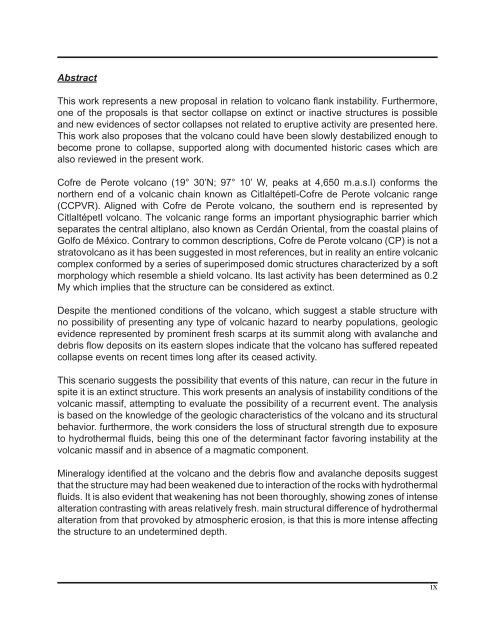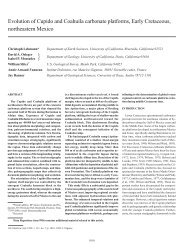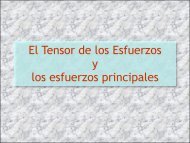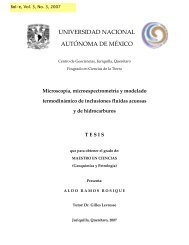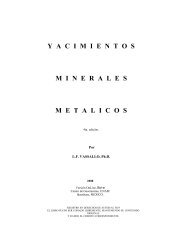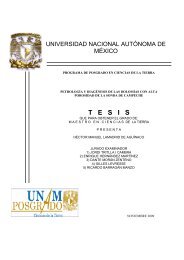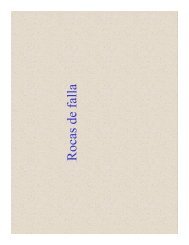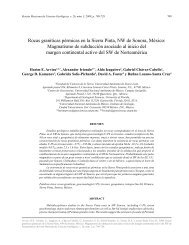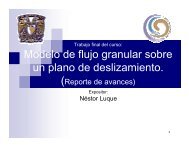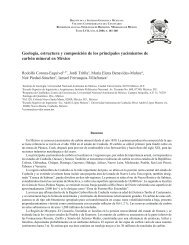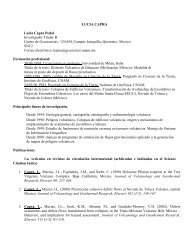Análisis de las Condiciones Estructurales de Estabilidad en el ...
Análisis de las Condiciones Estructurales de Estabilidad en el ...
Análisis de las Condiciones Estructurales de Estabilidad en el ...
Create successful ePaper yourself
Turn your PDF publications into a flip-book with our unique Google optimized e-Paper software.
Abstract<br />
This work repres<strong>en</strong>ts a new proposal in r<strong>el</strong>ation to volcano flank instability. Furthermore,<br />
one of the proposals is that sector collapse on extinct or inactive structures is possible<br />
and new evi<strong>de</strong>nces of sector collapses not r<strong>el</strong>ated to eruptive activity are pres<strong>en</strong>ted here.<br />
This work also proposes that the volcano could have be<strong>en</strong> slowly <strong>de</strong>stabilized <strong>en</strong>ough to<br />
become prone to collapse, supported along with docum<strong>en</strong>ted historic cases which are<br />
also reviewed in the pres<strong>en</strong>t work.<br />
Cofre <strong>de</strong> Perote volcano (19° 30’N; 97° 10’ W, peaks at 4,650 m.a.s.l) conforms the<br />
northern <strong>en</strong>d of a volcanic chain known as Citlaltépetl-Cofre <strong>de</strong> Perote volcanic range<br />
(CCPVR). Aligned with Cofre <strong>de</strong> Perote volcano, the southern <strong>en</strong>d is repres<strong>en</strong>ted by<br />
Citlaltépetl volcano. The volcanic range forms an important physiographic barrier which<br />
separates the c<strong>en</strong>tral altiplano, also known as Cerdán Ori<strong>en</strong>tal, from the coastal plains of<br />
Golfo <strong>de</strong> México. Contrary to common <strong>de</strong>scriptions, Cofre <strong>de</strong> Perote volcano (CP) is not a<br />
stratovolcano as it has be<strong>en</strong> suggested in most refer<strong>en</strong>ces, but in reality an <strong>en</strong>tire volcanic<br />
complex conformed by a series of superimposed domic structures characterized by a soft<br />
morphology which resemble a shi<strong>el</strong>d volcano. Its <strong>las</strong>t activity has be<strong>en</strong> <strong>de</strong>termined as 0.2<br />
My which implies that the structure can be consi<strong>de</strong>red as extinct.<br />
Despite the m<strong>en</strong>tioned conditions of the volcano, which suggest a stable structure with<br />
no possibility of pres<strong>en</strong>ting any type of volcanic hazard to nearby populations, geologic<br />
evi<strong>de</strong>nce repres<strong>en</strong>ted by promin<strong>en</strong>t fresh scarps at its summit along with avalanche and<br />
<strong>de</strong>bris flow <strong>de</strong>posits on its eastern slopes indicate that the volcano has suffered repeated<br />
collapse ev<strong>en</strong>ts on rec<strong>en</strong>t times long after its ceased activity.<br />
This sc<strong>en</strong>ario suggests the possibility that ev<strong>en</strong>ts of this nature, can recur in the future in<br />
spite it is an extinct structure. This work pres<strong>en</strong>ts an analysis of instability conditions of the<br />
volcanic massif, attempting to evaluate the possibility of a recurr<strong>en</strong>t ev<strong>en</strong>t. The analysis<br />
is based on the knowledge of the geologic characteristics of the volcano and its structural<br />
behavior. furthermore, the work consi<strong>de</strong>rs the loss of structural str<strong>en</strong>gth due to exposure<br />
to hydrothermal fluids, being this one of the <strong>de</strong>terminant factor favoring instability at the<br />
volcanic massif and in abs<strong>en</strong>ce of a magmatic compon<strong>en</strong>t.<br />
Mineralogy i<strong>de</strong>ntified at the volcano and the <strong>de</strong>bris flow and avalanche <strong>de</strong>posits suggest<br />
that the structure may had be<strong>en</strong> weak<strong>en</strong>ed due to interaction of the rocks with hydrothermal<br />
fluids. It is also evi<strong>de</strong>nt that weak<strong>en</strong>ing has not be<strong>en</strong> thoroughly, showing zones of int<strong>en</strong>se<br />
alteration contrasting with areas r<strong>el</strong>ativ<strong>el</strong>y fresh. main structural differ<strong>en</strong>ce of hydrothermal<br />
alteration from that provoked by atmospheric erosion, is that this is more int<strong>en</strong>se affecting<br />
the structure to an un<strong>de</strong>termined <strong>de</strong>pth.<br />
ix


